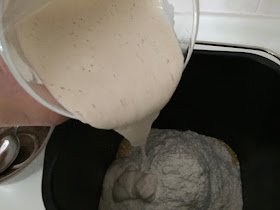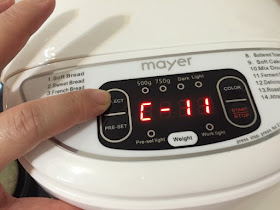Soft milk buns added with natural yeast for better aroma and texture. The buns were filled with moist grated coconut sweetened with palm sugar or gula melaka. The crust of the buns were sprinkled with dessicated grated coconut to give the plain bun its self-introducing identity ^^
Click the below link for non-natural yeast recipe:
Yield: 9 buns in a 20cm square pan
Bread maker: Mayer MMBM12
Bread weight: 591g
Raw dough weight: 447 g
Coconut filling椰丝内馅 (190g)
Ingredients
150g grated coconut, room temperature
椰丝,室温
50g gula melaka/palm sugar 椰糖
1 tsp red sugar 红糖 (optional 可免)
1/8 tsp salt 盐
30g water 水
1 pandan leaf (optional) 香兰叶
1/2 tsp glutinous rice flour 糯米粉
1 tbsp water to mix with glutinous rice flour 水,用来调糯米粉成糊
Direction
1. Dissolve palm sugar/gula melaka, red sugar and salt in 30g of water with pandan leaf under medium heat. Let the ingredients boil for a while in order for the fragrance of the pandan leaf to infuse into the sauce. Stir regularly.
2. Stir in the grated coconut and mix well.
3. Finally pour in the glutinous rice water and blend well. Stirring regularly till the mixture becomes slightly drier and sticky.
4. Remove the pandan leaf and transfer the sweetened coconut to a metal bowl to cool down. Set aside.
You can prepare this one day ahead and keep in the fridge.
Natural Yeast (100% hydration)
Day Temperature: 30 degree Celsius
Ingredients
60g natural yeast poolish dough
10g cool boiled water
10g unbleached bread flour
Click the link for the method of cultivating natural yeast:
Click the link on preparing the natural yeast poolish dough for baking:
Natural yeast poolish dough 1 1/2 hour after feeding
Bread dough
Ingredients
110g cold whole milk 冷全脂牛奶
20g condensed milk 炼乳
30g fine sugar 细糖
20g beaten egg 蛋液
1/4 tsp salt 盐
110g cold whole milk 冷全脂牛奶
20g condensed milk 炼乳
30g fine sugar 细糖
20g beaten egg 蛋液
1/4 tsp salt 盐
20g cold unsalted butter 冷无盐奶油
185g bread flour 高筋面粉
20g top/cake flour 低筋面粉
40g natural yeast 天然酵母面种
1/2 tsp instant dry yeast 即发干酵母
Some beaten egg and dessicated coconut for sprinkling on bread top
些许蛋液和干椰丝做表面装饰
Directions:
1. Line a 20cm square pan with parchment paper. Set aside.
2. Pour cold whole/fresh milk and condensed milk into the bread pan.
3. Add in beaten egg.
4. Add in sugar, salt and cold butter.
5. Pour in bread flour, top/cake flour and the natural yeast.
Adding the natural yeast poolish dough
6. Dig a hole and pour in the instant dry yeast.
7. Place the bread pan into the bread maker, select C-11 "ferment dough" function, and start the machine.
8. When the program stops, let the dough continues to proof in the bread pan for another 30 minutes.
30 minutes later.
9. Turn out the dough onto a floured surface. Flatten it with your palm to release the trapped air.
11. Roll up the small dough, pull down the sides several times to stretch out the dough surface, and seal at the bottom. Lightly coat with some flour and place on a plate, cover with a lid, and rest for 15 minutes.
12. After the rest, roll out the dough using a rolling pin. Keep the centre thicker than the edge.
13. Place the dough into the lined square pan. Spray some water and let the doughs proof for about 30 minutes in a warm oven, or till the doughs are touching each other.
14. Preheat the oven to 170 degree Celsius. Apply a thin coat of beaten egg over the dough surface.
Sprinkle with dessicated coconut.
15. Bake at 170 degree Celsius, at lower rack of the oven for about 17 to 20 minutes, or till the top turns golden.
16. Transfer the hot bread to cool on a wire rack. Enjoy ^^





















































So nice! You always bake great bread and buns. I wish I could do that too BTW, I notice that sometimes my buns turn quite sticky the next day. Could you please advise what could have gone wrong?
ReplyDeleteHi Jerin, thank you for your nice comment :)
DeleteI think probably your bread was not baked thoroughly, so there maybe still a higher moisture content in your bread.
Or, your bread was not cool completely before keeping.
If you use oil, butter or sugar in your glazing, the bread crust will tend to become sticky overnight.
Hope this info is relevant :)
My buns turned out to be a bit on the dry side. Do you know what has gone wrong? I find it dough can't be stretched, it will shrink when I tried to roll it.
ReplyDeleteHi Angela, from what your have described, your dough seemed too dry to be "stretchy". Different type of flour may have different liquid absorbancy. If you are using a bread maker, if the dough is too dry, you'll see the dough spinning round the axle without touching the wall of the pan. After about 8 to 10 minutes of kneading, if the dough is too dry, then you can add in a tsp of liquid drop by drop to the spinning dough. You can continue to add till the dough can occasionally stretch out to touch the wall of the pan.
DeleteHope this info help :)
Hi ngaileng,
ReplyDeleteI love your breads and your detailed explanation.
May I know how much instant dry yeast I can use to replace ur natural yeast?
Thank you!!
Thank you Min for liking my recipe presentation 💕
DeleteYou can omit the natural yeast from the recipe, just need to increase the milk from 110 to 120g. Keep the instant dry yeast as 1/2 tsp.
Hope you'll like the recipe 😁
Hi Ngaileng! your bun looks so soft and tasty :9 may i know if i can omit the dry yeast and substitute with natural yeast instead?
ReplyDeleteif i don't have bread machine, can i follow the steps you did when making sweet milk buns? Thanks :)
ReplyDelete